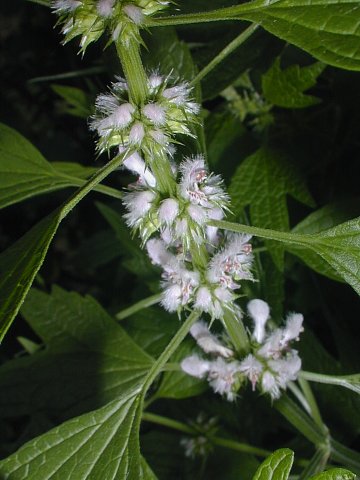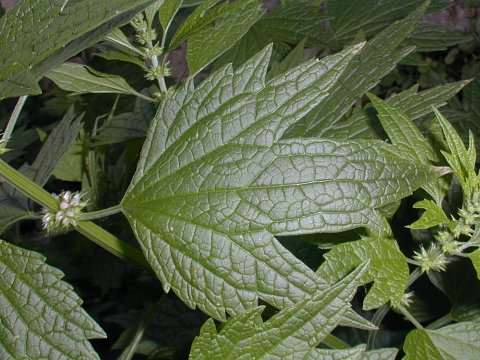Description: This herbaceous perennial plant is 2-5' tall and sparingly branched below the inflorescence. The stems are 4-angled, heavily ridged, and slightly pubescent. The opposite leaves are variable in size and shape, although they all have long petioles that are slightly pubescent. The lower leaves often have 5 cleft lobes and several coarse teeth; they are up up to 4" long and 3" across. The middle leaves have 3 cleft lobes and a few coarse teeth; they are up to 3" long and 1½" across. The upper leaves are often oblong-ovate with a pair of coarse teeth; they are up to 2" long and ¾" across. These leaves are nearly hairless and have conspicuous veins along the upper surface. The base of each leaf is more or less wedge-shaped. The stems of Motherwort are normally erect, although older plants toward the end of the growing season have a tendency to sprawl.

Whorls of sessile
flowers occur above the axils of the opposite leaves on the middle to
upper stems. Each tubular flower is 2-lipped and about 1/3" (8 mm.)
long. The
corolla is white or light pink and quite hairy on the upper side; these
fuzzy white hairs exceed 1 mm. in length. The upper lip is undivided,
while the lower lip has a central lobe and 2 smaller side lobes. There
are usually purple dots on the lower lip and near the throat of the
corolla. The tubular green calyx has 5 lanceolate teeth; it is slightly
pubescent. These teeth are sharp-pointed and persistent. The blooming
period occurs during the summer and lasts about 2 months. While the
flowers are not noticeably fragrant, the foliage has a slightly rank
odor. Each flower is replaced by 4 nutlets that are 3-sided and reddish
brown or brown. The root system consists of shallow fibrous roots and
rhizomes. This plant spreads by reseeding itself and vegetatively by
means of the rhizomes; it often forms colonies.
Cultivation:
The preference is partial sun and moist fertile soil. If the soil
becomes too dry, the lower leaves have a tendency to fall off and the
entire plant may wilt or die. Plants are attractive while young, but
become ragged in appearance with age.

Range &
Habitat:
Motherwort is a common plant in central and northern Illinois, but
uncommon or absent in southern Illinois (see Distribution
Map). It was introduced into the United States from Europe as
an herb with medicinal properties. However, Motherwort is originally
from central Asia (including Siberia). Habitats include open disturbed
woodlands, areas along woodland paths, woodland borders and thickets,
edges of degraded wetlands, edges of yards underneath trees, and
partially shaded fence rows. While Motherwort normally occurs in
disturbed areas, it can also invade higher quality woodland areas. This
plant is still sold by commercial nurseries as a medicinal herb.
Faunal Associations:
The flowers are pollinated by bumblebees and other long-tongued bees,
including little carpenter bees (Ceratina spp.) and
Anthophorine bees (Anthophora spp.); these insects
are attracted by nectar primarily. Syrphid flies and Halictid bees are
attracted to the pollen of the flowers, but they are less effective
pollinators. Occasionally the foliage is attacked by Tetranychus
urticae (Two-Spotted Spider Mite), which is polyphagous.
Mammalian herbivores avoid the foliage as a food source because it is
bitter-tasting and probably slightly toxic. It is possible that the
seeds are transported by mammals because the spine-like teeth of the
calyx can cling to fur (or clothing).

Photographic
Location:
Underneath a tree at the edge of a yard in Urbana, Illinois.
Comments:
Motherwort is one of many introduced members of the Mint family with
small tubular flowers. It has foliage with a somewhat distinctive
appearance and flowers that are exceptionally hairy. Motherwort belongs
to large group of plants in the Mint family that produce non-terminal
whorls of flowers above the opposite leaves; other groups in this large
family produce terminal racemes and spikes, or non-terminal flowers
that aren't whorled. The petioles of the Motherwort are longer than the
flowers, and its leaves have wedged-shaped bottoms and 3-5 cleft lobes
with pointed tips. Other species in the Mint family have petioles that
are shorter than the flowers, or their leaves have rounded bottoms and
unlobed margins. The other Leonurus sp. in
Illinois, Leonurus sibericus (Siberian Motherwort),
is a biennial plant with less hairy flowers (hairs less than 1 mm.) and
leaves that are more deeply cleft into narrow lobes.